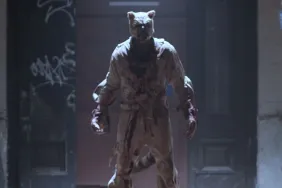
6.5 out of 10
The Walk Cast:
Joseph Gordon-Levitt as Philippe Petit
Ben Kingsley as Papa Rudy
Charlotte Le Bon as Annie Allix
Benedict Samuel as Jean-Louis
César Domboy as Jean-François
James Badge Dale as JP
Ben Schwartz as Albert
Steve Valentine as Barry Greenhouse
Directed by Robert Zemeckis
Review:
Philippe Petit (Gordon-Levitt) would like to be the greatest wire walker and (in his mind) daredevil the world has ever seen, even as the world has begun to decide it has seen enough of such things. It’s the sad fact of all magic that, as wondrous as it seems in the moment, it’s time is as fleeting as ours and what enthralls one generation is old hat for the next.
It’s a fact that bedevils both those who deal in magic and those who tell stories about them, because it requires explaining to those who may not share the context and may not understand already why what they’re seeing is special. And like a good joke spoiled, a trick that must be explained to be fully enjoyed loses some of its personality in the process.
The Walk is doubly inflicted by that problem as it attempts to use classic movie magic to recreate classic real world magic and unlike its hero cannot quite bridge the distance.
By nature of being both period about something which doesn’t exist in a current context, it is essentially backwards looking. High wire artists (or even Evel Knievel) have a very different place (and understanding) in a world of extreme sports while the World Trade Center has been gone long enough for current high school students to have grown up in a world where they never existed.
Looking behind is not an evil in and of itself – it’s always good to see where we’ve come from, it tell us where we’re going – but that requires remembering that the end result is still being created for the people before us who may not know intrinsically what we’re talking about, like translating an artwork from a foreign culture.
Co-writer/director Robert Zemeckis has a seemingly endless bag of visual tricks at his disposal – more than a few from his foray into animation – from continually changing our perspective of events (such as putting us inside the paper Philippe is writing on) to a camera which twists and bends impossibly around its subject.
A moment with a dropped balance beam is so effective in IMAX 3D that entire theaters will duck instinctively. One can only imagine the thrill a director must have watching an entire crowd of people move at his control, similar to an artist controlling a crowd from atop a high wire. But for all that, it amounts to a feeling of incessantly spinning plates being used to distract from the fact that the juggler is about to fall over.
It’s a sentiment that Petit – a gifted performer either at the circus or street level – can relate to, in part because he insists on taking his art to the edge and refuses to compromise even when no one will know but himself. It’s particularly stark view that cinema about artists likes but Gordon-Lovett keeps it, or many of the films other weak moments, from weighing The Walk down.
His good-natured affability synchronizes well with Petit’s own particular view on life and makes it easy to root for him even when his goal is as simple as successfully walking over a pond full of surly fishermen. He can’t undo some of the film’s stranger choices – the most notable being a future version of himself standing atop the Statue of Liberty narrating the story and frequently breaking the tension and flow of the story.
It’s the first (but not last) sign of the essential problem underlying The Walk as it is used to constantly tell the audience what people are thinking and feeling either so that it doesn’t have to be shown or because Zemeckis doesn’t have faith in his ability to do so.
And he should be worried, because the central idea the film is trying to communicate – the magic it is trying to recreate – is not there. Taking on greater and greater feats of daredevilry, including a wire walk between the spires of Notre Dame, Philippe eventually aspires to the greatest wire feat of them all – across the 140 foot span separating the World Trade Center towers, soon to be the tallest buildings in the world.
As a feat it is frequently referred to by other characters as subversive, magical, something that will change people, a ‘coup’ in Philippe’s words and The Walk assumes its audience will understand why (or will just go with it if told it is important often enough) rather than bother explaining why it’s important in the first place. The juggler starts to wobble.
Once the film’s goal is set, it moves from a recitation of Petit’s life to more of a caper or heist film (albeit one with an unusual goal) and gains a lot of energy from the transformation while giving Zemeckis for his best visual tricks as he ratchets up tension. Nothing personafies the moment so well as an ongoing injury to Philippe’s foot which is infrequently commented on (visually or verbally) and is easily forgotten until Zemeckis shows off the blood trail on the wire or the bottom of the slipper and starts tension ratcheting up again like an endlessly tautened wire. The juggler recovers.
But it also highlights The Walk’s essential flaw. The ability to pull off the caper is what the drama of the film is built around, which means its rationale must be understood. A regular caper film can fall back on greed or similar motives and that’s enough because they’re abstract concepts the audience can understand even if they don’t indulge. Why does a high-wire building walk matter to anyone but the man doing it?
The film is never able to adequately explain, and thus there are no stakes and without stakes … no drama. For all its visual brilliance, The Walk never manages to explain exactly what its goal is – or more specifically why anyone should care – because it’s not a film about Philippe at all but only about what he walked on.
It’s about the towers and their representation in a time before 9/11, a simpler time (just as the Statue of Liberty is in its way). It doesn’t jump out say that – Zemeckis is too good a filmmaker for that – but it expects the idea to be understood (the delivery of the final line makes no sense without that understanding) and little is offered to explain the movie without that built-in context. The magician must never assume the audience carries in the knowledge needed to appreciate the trick without explaining because if when the wrong estimate is made everyone stops looking at the stage and starts playing with their phones. And once the magic is gone, it’s not coming back.









